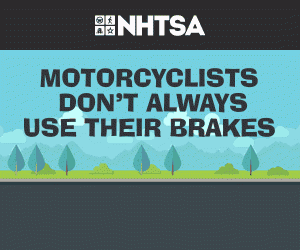Get Up to Speed on Motorcycles.
Motorcyclists and Motorists Can Work Together to Save Lives.
Motorcyclists Are at Great Risk on Our Roadways.
- With thousands of deaths each year, motorcyclists are significantly overrepresented in traffic crashes and fatalities.
- According to the National Highway Traffic Safety Administration (NHTSA), motorcyclists accounted for nearly 14 percent of all traffic fatalities in 2015, while motorcycles make up just 3 percent of all registered vehicles in the United States.
- In 2015, 4,976 motorcyclists killed in motor vehicle crashes – an 8 percent increase from the 4,594 killed in 2014. And more than 88,000 motorcyclists were injured in motor vehicle crashes.
- Per vehicle mile traveled, motorcyclists are about 27 times more likely than passenger vehicle occupants to die in a motor vehicle crash, and 5 times more likely to be injured.
- Even the smallest momentary lapse in a vehicle driver’s awareness can result in the death of an unseen motorcyclist.
- To help reduce motorcycle collisions and injuries and to help save lives, 2Pass Defensive Driving is teaming with NHTSA to launch the new Get Up to Speed on Motorcycles campaign to help motorists understand standard motorcycle driving behaviors and to learn how to drive safely around motorcycles on our roadways.
Motorcycles Are Hard to Spot and Easy to Hit.
- Because they are small and have greater maneuverability than cars and trucks, motorcycles can be difficult to see or spot on the roadway, and motorists have difficulty judging their distance and speed.
- In 2015, 54 percent of all motorcycles (2,761) involved in fatal crashes collided with another motor vehicle.
- Motorists making left turns at intersections are one of the most common causes of motorcycle crashes, due to motorists’ difficulty judging the distance and speed of motorcycles.
- Of all two-vehicle fatal crashes involving a motorcycle and another type of vehicle in 2015, 41 percent (944) of the crashes resulted from a motor vehicle turning left while the motorcycles were going straight, passing or overtaking other vehicles.
- Blind spots also increase a motorist’s risk of overlooking the presence of a motorcycle. Up to 40 percent of a motor vehicle is in a blind spot, and a motorcycle can be easily hidden in a vehicle’s blind spot because of its narrow profile.
Driving a Vehicle is Different than Driving a Motorcycle.
- Though a motorcyclist’s driving behavior on the road may sometimes seem strange or reckless, there are reasons why driving a motorcycle can be different than driving a passenger vehicle.
- A motorcyclist’s “braking” is not always obvious to motorists. Motorcycles decelerate faster than vehicles, so motorcyclists will often downshift instead of applying the brake, especially when driving around a curve. This means the brake lights will not be engaged to signal motorists of deceleration or an upcoming stop.
- A motorcyclist’s weaving from left to right within a lane of traffic is a safe and legitimate behavior.
- Misunderstanding, misjudging or overlooking a motorcycle can lead to a crash and cost someone a life.
Drivers — Follow These Tips to Share the Road Safely with Motorcyclists:
- Slow down, assess your surroundings, and don’t rush when crossing intersections, entering the roadway from a parking lot or driveway, or turning left. Always give yourself enough time to thoroughly check for motorcyclists.
- When turning left, ensure there is enough time and space for the motorcyclist to clear the roadway before you initiate the left turn.
- Don’t follow motorcyclists too closely and allow sufficient braking cushion between your vehicle and the motorcycle in front of you to give your vehicle enough room to come to a complete stop without a collision. Remember, a motorcyclist’s brake lights might not always be engaged when a motorcycle decelerates.

